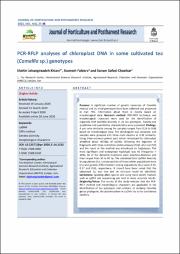PCR-RFLP analyses of chloroplast DNA in some cultivated tea (Camellia sp.) genotypes
(ندگان)پدیدآور
Jahangirzadeh khiavi, ShahinFalakro, KooroshSafaei Chaeikar, Sanamنوع مدرک
TextOriginal Article
زبان مدرک
Englishچکیده
Purpose: A significant number of genetic resources of Camellia sinensis and its allied genotypes have been collected and preserved in Iran TRC. Information about them is mostly based on morphological data. Research method: PCR-RFLP technique and morphological characters were used for the identification of organelle DNA (cpDNA) diversity in 25 tea genotypes. Twenty-one qualitative and quantitative characteristics were evaluated. Findings: A pair-wise similarity among the samples ranged from 0.14 to 0.66 based on morphological data. The dendrogram was designed, and samples were grouped into three main clusters at 0.38 similarity. Using three universal primer pairs which introduced for chloroplast amplified about 4070bp of cpDNA, following the digestion of fragments with three restriction endonucleases (HinfI, AluI and PstI) and the result of this method was introduced six haplotypes. The most significant and widespread haplotype was H2 (frequency ≈ 28%). All of the detected mutations were insertion-deletions and they ranged from 30 to 60 bp. The calculated total cpDNA diversity in populations (hT), a major portion of it was within populations were (hS) and genetic differentiation among populations (GST) were 0.43, 0.17 and 0.61, respectively. It should have been noted that the calculated GST was low and no structure could be identified. Limitations: Applying allied species and using more potent markers such as cpSSR and sequencing can lead to more accurate results. Originality/Value: The results of this study indicate that the PCR-RFLP method and morphological characters are applicable in the identification of tea genotypes and cultivars. In studying Camellia genus phylogeny, the polymorphism in cpDNA has to be considered carefully.
کلید واژگان
cpDNACAPs method
Genetic diversity
Morphological characters
Biotechnology and Tissue culture
شماره نشریه
1تاریخ نشر
2021-03-011399-12-11
ناشر
University of Birjandسازمان پدید آورنده
Tea Research Center, Horticultural Sciences Research Institute, Agricultural Research, Education and Extension Organization (AREEO), Lahijan, IranTea Research Center, Horticultural Sciences Research Institute, Agricultural Research, Education and Extension Organization (AREEO), Lahijan, Iran
Tea Research Center, Horticultural Sciences Research Institute, Agricultural Research, Education and Extension Organization (AREEO), Lahijan, Iran
شاپا
2588-48832588-6169





